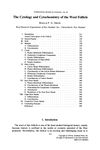The study examined the formation of surface membranes in developing mammalian hair fibers, specifically using Merino sheep skin biopsies. It was found that the formation of the fiber cuticle (FC) surface is similar to processes in the epidermal stratum corneum. Initially, FC cells have a plasma membrane adjacent to the inner root sheath (IRS) cuticle, separated by an intercellular space. As the hair matures, exocuticular lamellae form, the FC surface membrane degrades, and intercellular laminae with a stained central band appear. This leads to the cleavage between IRS cuticle and FC, releasing the hair into the pilary canal. The mature hair surface consists of keratinized cells with a developed exocuticle and a-layer, coated with paired laminae derived from intercellular laminae, challenging previous beliefs that the cuticle surface membrane is a modified plasma membrane.
 90 citations
,
January 1979 in “International review of cytology”
90 citations
,
January 1979 in “International review of cytology” Wool follicles are complex, involving interactions between different cell types and structures.
 75 citations
,
November 1965 in “Textile research journal”
75 citations
,
November 1965 in “Textile research journal” Papain and bisulfite break down human hair by dissolving parts of it.
April 2019 in “The journal of investigative dermatology/Journal of investigative dermatology” A specific mutation in the TRPV3 gene causes hair follicle cells to develop improperly, leading to hair loss.
45 citations
,
April 2001 in “The journal of investigative dermatology/Journal of investigative dermatology” Different Myc family proteins are located in various parts of the hair follicle and may affect stem cell behavior.
10 citations
,
October 2000 in “PubMed”  94 citations
,
February 1994 in “The journal of investigative dermatology/Journal of investigative dermatology”
94 citations
,
February 1994 in “The journal of investigative dermatology/Journal of investigative dermatology” EGF makes hair follicles grow longer but stops hair production.
59 citations
,
August 1981 in “PubMed” Trichilemmal keratinization is a unique process in hair follicles where the outer root sheath turns into keratin without a specific layer.


